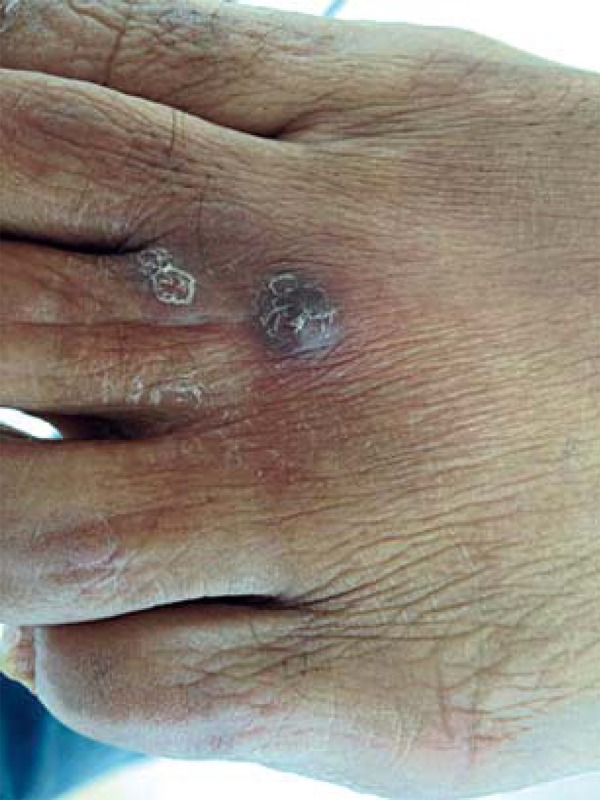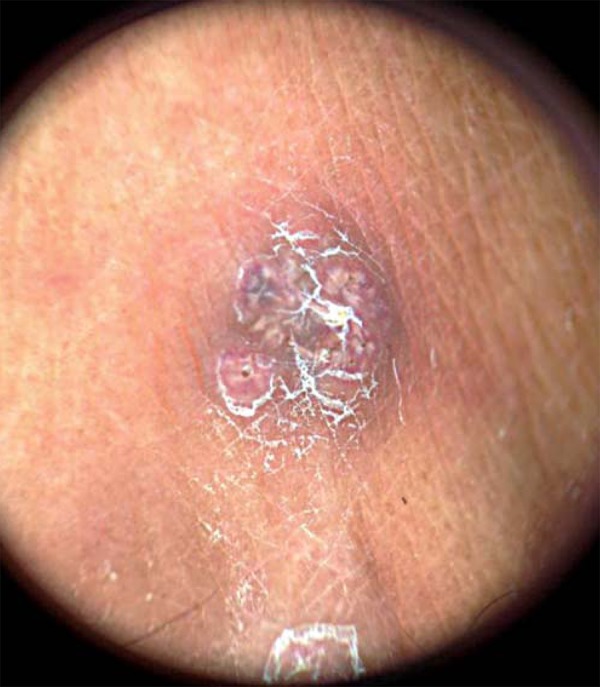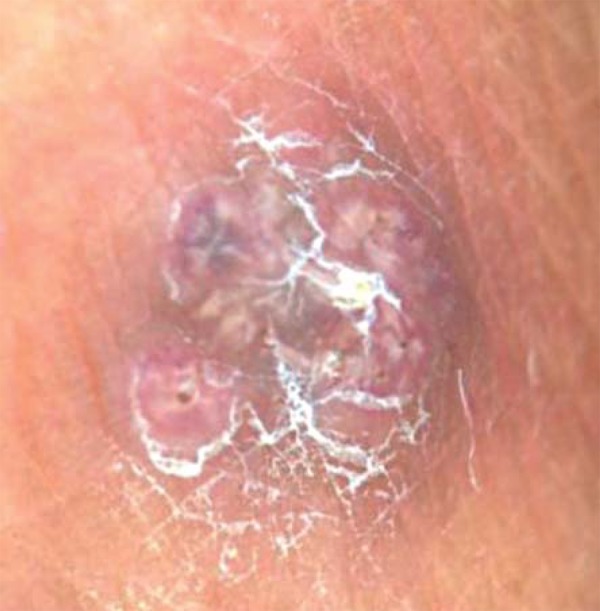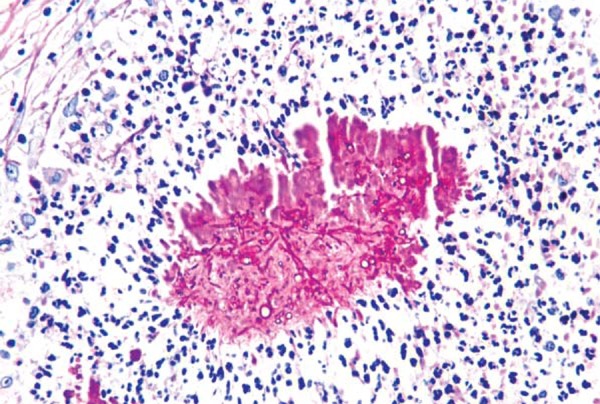Abstract
Mycetomas are a chronic skin infection characterized by perilesional edema, formation of sinus tracts, and discharge of purulent or seropurulent exudate containing grains. This report aims to demonstrate the clinical diagnosis (by dermoscopy) of a skin lesion that initially bared no clinical features of a mycetoma.
Keywords: Acremonium, Dermoscopy, Mycetoma
Mycetoma is a chronic infection of the skin characterized by perilesional edema, formation of sinus tracts, and discharge of purulent exudate containing grains.1 It is confirmed by pathology and culture.2,3 This report outlines the case of a clinically nonspecific cutaneous lesion, in which the dermoscopy led to the clinical hypothesis.
A 47 year-old female, from the urban area of Rondonia, was referred to the Dermatology Service of a Hospital in Curitiba, with an asymptomatic 4 year-old lesion on her left foot that underwent spontaneous resolution. Three months before, a new lesion had appeared in the same area, with serosanguineous drainage. Examination revealed a violate nodular lesion, scaly and rough, on the base of the third left toe (Figure 1). Upon dermoscopy, (DermLite®, Gen, INC.) yellowish and white structures were identified (Figures 2 and 3). Excisional biopsy was performed, pathology with PAS stain showed suppurative granuloma with grains and hyaline septate hyphae (Figure 4). The tissue culture revealed Acremonium sp , confirming the diagnosis of Eumycetoma. The authors established an adjunctive therapy with Itraconazole 100 mg PO bid. The patient remains in remission.
FIGURE 1.

Papular-nodular lesion, violet to brown, slightly scaly, rough and dull on the base of the third left toe
FIGURE 2.

Upon dermoscopy, whitish and yellowish structures
FIGURE 3.

Dermoscopy (higher magnification)
FIGURE 4.

Suppurative granuloma containing grains and hyaline septate hyphae)
It is known that dermoscopy improves diagnostic accuracy in pigmented lesions. Nowadays, its application is also extending to diagnostic reports of skin infections, as well as to follow-up benign neoplasms.4 As mycetomas are usually clinically evident, there are no studies of their typical features on dermoscopy. However, in uncertain cases, the method is being increasingly applied in clinical practice.5
Footnotes
Conflict of interest: None
Financial funding: None
Work performed at the Hospital Universitário Evangélico de Curitiba - Faculdade Evangélica do Paraná (HUEC-Fepar) - Curitiba (PR), Brazil.
How to cite this article: Reis LM, Lima BZ, Zillo FC, Rezende CM, Fabricio LHZ, Pinto CAS. Dermoscopy assisting the diagnose of a Mycetoma: case report and literature review. An Bras Dermatol. 2014;89(5):832-3.
REFERENCES
- 1.Ruiz LR. Zaitz C, Campbell I, Marques SA, Ruiz LRB, Framil VMS. Compêndio de Micologia Médica. 2 ed. Rio de Janeiro: Guanabara Koogan; 2010. Micetomas Eumicóticos; pp. 206–211. [Google Scholar]
- 2.Sampaio SA, Rivitti EA. Sampaio SA, Rivitti EA. Dermatologia. 3 ed. São Paulo: Artes Médicas; 2008. Micoses profundas; pp. 723–752. [Google Scholar]
- 3.Hoffmann Cde C, Danucalov IP, Purim KS, Queiroz-Telles F. Infections caused by dematiaceous fungi and their anatomoclinical correlations. An Bras Dermatol. 2011;86:138–141. doi: 10.1590/s0365-05962011000100021. [DOI] [PubMed] [Google Scholar]
- 4.Bastos CA. Indicações não tradicionais de dermatoscopia. Surg Cosmet Dermatol. 2012;4:203–205. [Google Scholar]
- 5.Tedesco-Marchese LM, Castro RM, Lacaz CS, Cucé LC, Salebian A, Sotto MN. Acremoniose cutânea: relato de um caso. An Bras Dermatol. 1987;62:25–30. [Google Scholar]


